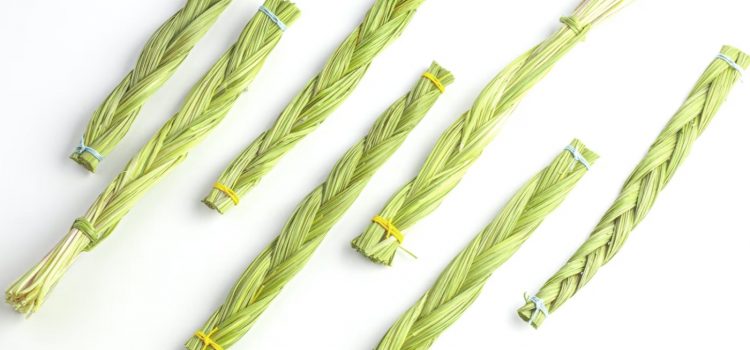

This article is an excerpt from the Shortform book guide to "Braiding Sweetgrass" by Robin Wall Kimmerer. Shortform has the world's best summaries and analyses of books you should be reading.
Like this article? Sign up for a free trial here.
What can sweetgrass teach us? What do the strands of sweetgrass mean?
Braiding Sweetgrass by Robin Wall Kimmerer is a collection of essays that integrate plant relationships, Anishinaabe Indigenous worldviews, and scientific knowledge. These three components represent the strands of a braid of sweetgrass, a sacred plant in the Indigenous Potawatomi culture.
Keep reading to learn about sweetgrass teachings from Braiding Sweetgrass.
How Plants Teach Us About Mutual Care
One example of sweetgrass teachings is the observation of plants. Observing plants provides insight into how mutual care helps individuals and communities flourish. Plants engage cooperatively in symbiotic relationships, collective solidarity, natural succession, and generosity, which can inspire us to practice mutual care with other humans as well as non-human beings.
Symbiotic Relationships
Plants often have symbiotic relationships in which different species work together in a way that benefits both of them.
Kimmerer illustrates this principle with the example of a lichen. A lichen is an organism composed of fungi and algae. The fungi decompose organic matter to nourish the lichen with water and minerals. They also hold in moisture and protect the lichen from the sun. The algae provide food for the lichen by photosynthesizing sunlight into sugar.
Because of their differences in feeding strategies, the decomposers (fungi) and producers (algae) can cooperate to meet their basic needs. Similarly, humans can interact with other organisms in a mutually positive way.
Collective Solidarity
In addition to the symbiosis between different species, collective solidarity within a species is another way that plants demonstrate mutual care. When plants exhibit collective solidarity, they act in a unified way that helps the whole group survive.
The author describes how pecan trees demonstrate collective solidarity when they participate in “mast (or synchronous) fruiting”: All of the pecan trees in a region produce a heavy crop of nuts in the same year to overwhelm seed predators (such as squirrels) and increase the trees’ chance of reproducing via seed. In this process:
- A massive quantity of pecans in one season causes a spike in the squirrel population.
- The large squirrel population drives an increase in the number of predators that feed on squirrels.
- The pecan trees all stop producing nuts at the same time that the predator population is high, causing the squirrel population to plummet.
- The pecan trees mast fruit again when the squirrel population is at a low point, increasing the chance of their seeds taking root.
The strategy of mast fruiting works because all of the pecan trees in a region participate regardless of their microclimate or individual resources.
Kimmerer relates this principle to the human world with an example of failed collective solidarity. The federal government offered the Anishinaabe people (who had been displaced multiple times) citizenship and legal protection for their land if they agreed to relocate again and convert their communally owned territory into small plots, privately owned by individual families.
The Anishinaabe eventually agreed, and the process of fracturing their common land ultimately made each family more economically vulnerable. Many lost their land due to the tax burden or predatory purchasing tactics. Over two-thirds of their total Indigenous land was eventually lost. Kimmerer suggests that if her people had been able to retain their community structure, they would have been more resilient long term.
Natural Succession
Another way plants provide a model for mutual care is through the process of natural succession. Kimmerer explains that in natural succession, plants and animals act sequentially to restore an ecosystem after a disturbance, such as clear-cutting a forest, pollution from toxic chemicals, or a natural disaster. Each species creates the conditions for a new species to thrive, and the overall health of the ecosystem is restored over time.
Generosity and Cyclical Gifting
The last characteristic of plants that teaches mutual care is generosity and cyclical gifting. Kimmerer describes how plants act generously by providing many resources that meet the basic needs of other plants, animals, and people. In ecological systems, those gifts are continually replenished and recycled because they are interdependent with other species.
In human communities, gift-giving encourages mutual care because when someone cooks a meal for us or gives a thoughtful gift, it makes us want to give back to the other person.
How Traditional Indigenous Culture Teaches Mutual Care
Indigenous culture is the second source of inspiration and knowledge for how to practice mutual care with other beings. Kimmerer draws on three main areas of Indigenous culture that embody this concept: stories and language, honorable harvesting, and ceremony.
Stories and Language
Cultural lore and language conventions in Indigenous culture embody mutual care by honoring the life of non-human beings and acknowledging our interdependence, particularly through the Windigo mythology and animate verbs and nouns.
Honorable Harvesting
In addition to stories and language, the Indigenous concept of honorable harvesting teaches us about mutual care by encouraging us to take care of natural resources. Kimmerer’s description of the Honorable Harvest includes guidelines for being considerate when harvesting wild fruits, medicinal plants, mushrooms, or other materials like bark and minerals.
1. Take only what you need, never take the first or last, and never take more than half of whatever you’re harvesting. This ensures there’s enough for others.
2. “Ask” first. This could be a visual or logical assessment of whether the population is healthy enough to withstand some harvesting. It could also be a more spiritual or intuitive understanding of whether the plant or animal should be taken.
3. Give a gift in return. You could offer a gift to the plant you harvested by sowing its seeds or by putting compost under a tree that you harvested fruit from.
4. Use it well. Use the material well by making a useful tool or enjoying a meal, as opposed to letting it go to waste or storing it for no particular reason.
Ceremony
In addition to their language and harvesting practices, ceremony is another way Indigenous people hold their communities accountable for their values of gratitude and mutual care. Ceremonies accomplish this through outward expressions of gratitude (such as song and dance) and by incorporating practical ways of caring for living beings.
How Science Can Help Us Practice Mutual Care
Now that we’ve covered how plants and Indigenous wisdom can teach us to practice mutual care, we’ll look at how science also symbolizes sweetgrass. Species identification and research enables mutual care by increasing your familiarity with the natural world and providing evidence for how to be better land stewards.
Species Identification
Learning scientific taxonomy (the organization of species by groups and Latin names) is one way that science can contribute to a practice of mutual care. While Kimmerer notes that science is sometimes a reductive and mechanistic lens for viewing nature, it also provides a framework for recognizing and growing a relationship with another species.
For example, if you learn the Latin name for yarrow and its unique identifying characteristics, you might then notice it in the wild and harvest it for medicinal uses. You can make observations about what that plant needs to thrive and how you might cultivate it. Identification is a first step in establishing this mutually beneficial relationship.
Guidance From Research on Land Stewardship
Scientific research can also contribute to mutual care by providing information on how to restore ecological systems. One of Kimmerer’s examples of this is a study on sweetgrass showing that harvesting sweetgrass according to Indigenous practices helps it thrive, while leaving it alone diminishes it. Professors initially dismissed the research topic as useless, based on their assumption that harvesting plants is inherently harmful. However, the research illuminated a way that we can practice mutual care by maintaining an important species.

———End of Preview———
Like what you just read? Read the rest of the world's best book summary and analysis of Robin Wall Kimmerer's "Braiding Sweetgrass" at Shortform.
Here's what you'll find in our full Braiding Sweetgrass summary:
- What plants, Indigenous worldviews, and science can teach us about restoring balance
- Why we must recognize our interdependence on others and the environment
- Strategies to help you practice mutual care in your own life






